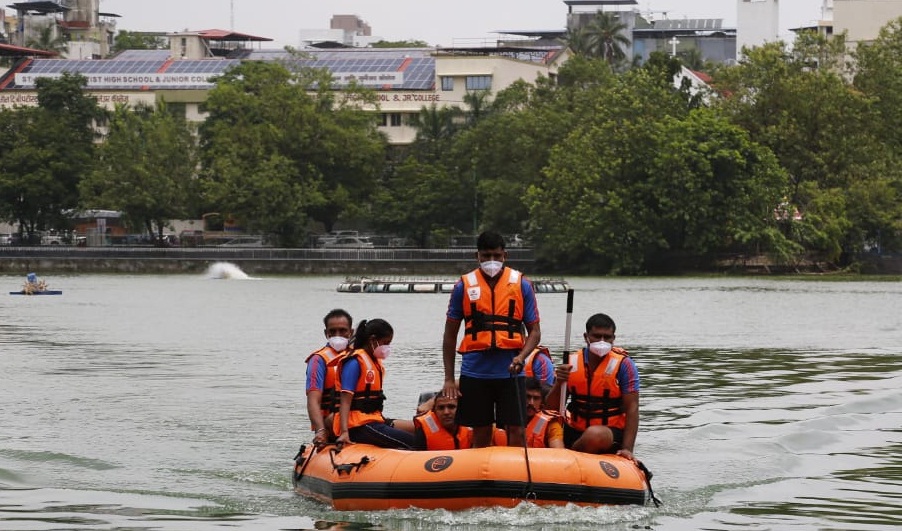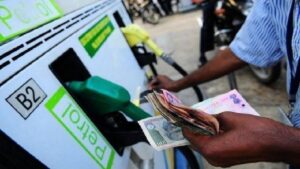Learning Lessons From Past, Railway Team Conducts Mock Drill In Rescue And Relief Ahead Of Rainy Season

Sumit Singh & Sushant Ranjan
Mumbai, 15th June 2021: Alok Kansal, General Manager Central and Western Railway in presence of Arun Kumar, Director General, Railway Protection Force (RPF) today briefed on monsoon preparedness of railways. They addressed a press conference at Talao Pali Lake in Thane.
He briefed about the pre-monsoon action taken over Mumbai suburban sections of Central and Western Railways like 7 additional waterways by microtunneling method at Kurla-Vidyavihar, Sandhurst Road and Masjid, Bandra, Vasai-Nallasopara; 4 additional waterways through RCC box insertion at Wadala-Ravli, Panvel-Karjat, Badlapur-Vangani and Kurla-Tilak Nagar: customized solutions taken for flooding spots of previous monsoons like construction of drains along tracks, retaining walls to prevent ingress of water, about 4 lakh cubic meter muck removal, etc. He said these infrastructure upgrades have improved suburban operations in the past few years.
Kansal said that recently Minister of Railways, Piyush Goyal reviewed the monsoon preparations and emphasized on adopting a holistic and long term plan. He suggested Railways to partner with Institutions like IIT Mumbai to study the efficiency of technical and civil work initiatives of Railways and local municipal corporations in handling monsoon rains.
RPF DG Arun Kumar said that suburban railways are the lifeline of Mumbai. He said our first act in such emergencies is to ensure passengers do not panic. Minister of Railways while reviewing the monsoon preparations was impressed by the Railway’s Flood Relief Team at Mumbai which uses boats with their force personnel. The teams are trained by NDRF for such emergencies. He also said that Railway Teams are ready for any such incidents and they are the first to reach and provide rescue and relief operations.
Kansal and Kumar have released the SOP for usage of boat and outboard motor by the Railway Flood Relief Team. They inspected the Mock Drill conducted by RFRT at Talaopali Lake demonstrating rescue and relief of passengers in a train held up in a waterlogged area. They also interacted with the RFRT personnel and encouraged them.
Ajoy Sadany, Principal Chief Security Commissioner, Central Railway, P.C. Sinha, Principal Chief Security Commissioner, Western Railway, Shri Shalabh Goel, Divisional Railway Manager, Mumbai Division, and other officials were present on the occasion. All covid protocols were followed.
Railway Protection Force have formed a Railway Flood Relief Team (RFRT) in Mumbai Division, equipped with motorized boats and trained manpower. The objective is to provide relief in case of floods in Railways. To predict and wherever possible, prevent disasters, mitigate their impact and effectively cope with the consequences by designing effective, realistic and coordinated planning and increase the overall effectiveness.
As such, 5 Motorised Inflatable Boats with all accessories and safety equipment have been procured and stationed at various vulnerable locations. These boats can be moved at any location wherever required for immediate response. Each FRT team consists of one Sub-Inspector/Assistant Sub-Inspector and 6 other staff. So far, 15 RPF staff (5 women and 10 men) have been trained by NDRF. Training is being provided to more RPF personnel.
The team will be always in readiness during monsoon i.e. from June to October every year. The teams will continuously monitor the rainfall especially during the days of high tide or when heavy rain is predicted by the Meteorological Department and move to the place from where flooding is reported irrespective of the fact that the train is held up or not. The team shall maintain liaison with their counterparts in Civil Administration, GRP, Disaster Management Authorities and Control Room. In addition to this, RPF have formulated a well detailed SOP for the Railway Flood Relief Team viz.
Blue Alert – when the water level reaches four inches above rail level, preparation starts for movement
Orange Alert – when the water level reaches five inches above rail level, team moves to the location
Red Alert – when train is held up at any location, a relief operation starts after ensuring the water level is three feet at the location.







